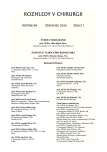Laparoscopy in the Management of Invagination in Pediatric Patients
Authors:
P. Omaník; V. Cingel; Babala J. Béder I.
Authors‘ workplace:
Univerzity Komenského v Bratislave, Slovenská republika, prednosta: doc. MUDr. Ján Trnka, CSc.
; Klinika detskej chirurgie Detskej fakultnej nemocnice s poliklinikou a Lekárskej fakulty
Published in:
Rozhl. Chir., 2010, roč. 89, č. 7, s. 406-410.
Category:
Monothematic special - Original
Overview
Aim:
During the last decade, many articles on indications, contraindications, benefits and risks of laparoscopic desinvagination procedures in children have been prosented in scientific literature. However, this therapeutic procedure has become a standard therapeutic option within the range of pediatric laparoscopic precedures. The aim of the authors was to establish this miniinvasive procedure in their clinic.
Patients and methods:
From January 2006 to December 2009, the authors operated 19 patients with ileocolonic invaginations, in whom prior hydrostatic desinvagination had failed. 11 pediatric patients underwent laparotomic revision. In 9 subjects, idiopatic invagination was detected, while in 2 subjects secondary intususception caused by a Meckel’s diverticle was confirmed during the procedure. In 7 subjects aged 8–51 months, desinvagination was achieved using laparoscopic procedures. 3 ports were used during the procedures – one for optic devices, measuring 10 mm, was placed in the infraumbilical incision and 2 working ports of 5 mm were introduced into the left hypogastrium and the left mesogastrium. The desinvagination was achieved using a grasper and gentle traction on the invaginated colon. In two subjects with relapsing invagination, desinvagination was followed by ileo-coecopexy. In one subject, conversion was required during the laparoscopic procedure, because repositioning of the invaginated colon was not feasible.
Outcomes:
The mean duration of these laparoscopic procedures was 68.6 minutes and no intraoperative complications were recorded. Reallimentation was introduced on the first postoperative day, no reinvagination episodes were recorded and the mean duration of hospitalization was 4.3 days.
Conclusion:
Laparoscopic desinvagination has become a part of the algorithm for the management of invaginations in cases, where conservative approach failed, and should be used before open laparoscopic revision is indicated. However, the miniinvasive procedure must be performed by a surgeon with experience in laparoscopy.
Key words:
invagination – laparoscopy
Sources
1. Poddoubnyi, I. V., Dronov, A. F., Blinnikov, O. I., et al. Laparoscopy in the treatment of intussusception in children. J. Pediatr. Surg., 1998; 33: 1194–1197.
2. Tošovský, V. Náhlé příhody břišní u dětí – včasná diagnostika. Praha, Grada Publishing, 1996.
3. Bailey, K. A., Wales, P. W., Gerstle, J. T. Laparoscopic versus oper reduction of intususception in children: a single-institution comparative experience. J. Pediatr. Surg., 2007; 42: 845–848.
4. Dronov, A. F., Poddoubnyi, I. V., Smirnov, A. N., et al. Laparoscopy in the tretment of intestinal invagnation in children. Khirurgiia, 2003; 11: 28–32.
5. Kia, K. F., Mony, V. K., Drongowski, R. A., et al. Laparoscopic vs open surgical approach for intussusception requiring operative intervention. J. Pediatr. Surg., 2005; 40: 281–284.
6. Lai, I. R., Huang, M. T., Lee, W. J. Mini-laparoscopic reduction of intussusception for children. J. Formos. Med. Assoc., 2000; 99: 510–512.
7. van der Laan, M., Bax, N. M. A., van der Zee, D. C. The role of laparoscopy in the management of childhood intussusception. Surg Endosc, 2001; 15: 373–376.
8. Al-Qahtani, A. R., Almaramhi, H. Minimal acces surgery in neonates and infants. J. Pediatr. Surg., 2006; 41: 910–913.
Labels
Surgery Orthopaedics Trauma surgeryArticle was published in
Perspectives in Surgery

2010 Issue 7
Most read in this issue
- Small Intestine Invagination in an Adult
- Ovarial Hyperstimulation Syndrome in the Differential Diagnostics of Acute Abdomen
- Uncommon Rectal Adenocarcinoma Metastases
- Significance of the Sentinel Lymph Node Biopsy in Early Breast Carcinomas
